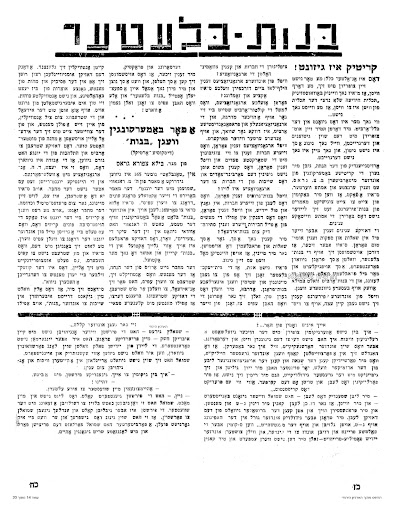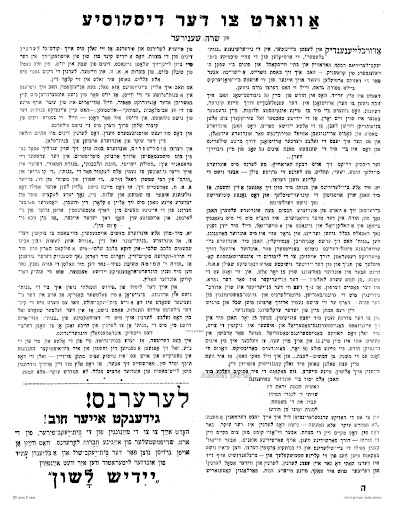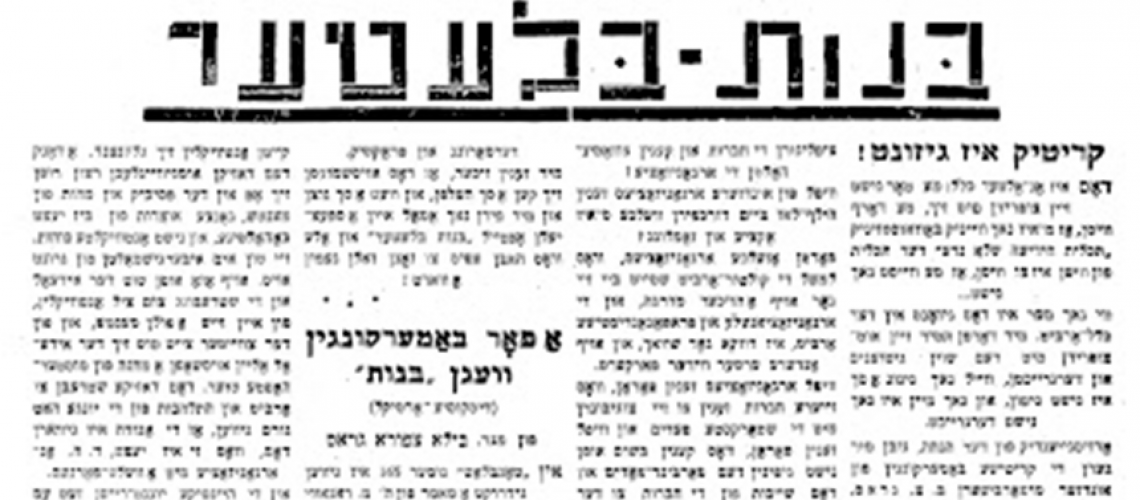The section “Bnos Pages” (Bnos-bleter) was launched in issue 105 of the Bais Yaakov Journal, published in May-June 1933. The first essay, which introduced the new section to the readership of the journal and explained its purpose, had no byline, but it was probably written by the editor of the journal, Eliezer Gershon Friedensohn, who was also the founder of Bnos, the youth movement of Bais Yaakov. As the essay explained, the new section was an initiative of Beile Tziporah Gross, who worked at the journal; Gross was critical of the way the journal often failed to address difficult issues in the movement. Although the journal readily published articles and essays by the young women who led Bnos, these articles tended to shy away from controversial subjects. But the adolescent Bnos members regularly dealt with difficult and neglected issues and often struggled with questions and doubts. According to the introductory article, the goal of “Bnos Pages” was to address those questions head-on: open discussions of these difficult problems might help Bnos members to find the answers they were looking for. The essay ends with an invitation to Bnos members to contribute material to the new section, and thus let their voices be heard.

Gross’ article in the same issue delves into some of these neglected issues: she discusses the Bnos’ members and the crisis of young people who feel unhappy, search for a higher purpose in life, and are uncertain of their futures. For Bnos’ leaders and members, the crisis might arise from their sense of failure to live up to Bnos ideals. If a member feels she cannot live up to those ideals, she might quit the movement entirely. One possible solution to this problem would be to publicize how individual chapters dealt with these challenges, and develop an overall approach for a pedagogy of the movement.

With this admirable goal in mind, the section—at first sporadically—became a regular feature of the journal. In issue 109, after two issues with no “Bnos Pages”, the section appeared again with an explanation that the goal was to publish in each and every issue, a goal that was stymied by two main issues: the first was the organizational difficulty of editing and maintaining a new section, and the second was the lack of appropriate materials. The “Bnos Pages” section aimed to feature the voices of Bnos members and other young women, and most of the texts published in this section were indeed written by women. In this article the editorial staff put out another call again for submissions, explaining that they were not looking for literary texts, but rather for articles that discussed controversial issues in accessible language, the same language someone might use in talking to a friend. Despite these clear intents, some of the articles were still written by the largely male staff of the journal, and in particular by its indefatigable editor-in-chief, Friedensohn.

Although the articles and call for submissions explicitly expressed the need to discuss difficult subjects, and the Bnos ethos included open discussion and debates, the discourse was actually limited and self-governed. In her book Sarah Schenirer and the Bais Yaakov Movement: A Revolution in the Name of Tradition, Naomi Seidman demonstrates those limits through a reading of the autobiography of a young woman writing under the pseudonym ‘Esther’, which was submitted to the YIVO autobiography contest. ‘Esther’ was a teacher in a failed Bais Yaakov school, and a member of Bnos. In her writing she describes the Bnos ethos of conducting a debate following the Talmudic model but reveals its underlying goal of reaffirming the correctness of their way. Her Bnos group was unhappy with her, since she too often opposed the expressed mainstream opinions of the movement. As Seidman notes: “The taste for passionate debate was constrained in Bais Yaakov (and Bnos) culture by unwritten rules about how far one could go.”1
Perhaps because the Bnos Pages discussions were in fact all aligning with the ideals of the movement and reaffirming them, it was embraced by the head of the movement. In issue 107, which did not include the new section, Sarah Schenirer dedicated an essay to the new “Bnos Pages”. For Schenirer, this initiative was the best gift for her upcoming fiftieth birthday, as she writes: “It is my pride and joy, that during the month I turned fifty, I had the honor of hearing public expressions by my children, ideas that expressed my most intimate dreams”. To see her students become teachers, along the path she had paved and dreamed of, was a blessing for her. In the next “Bnos Pages” published in issue 109, Rivkah Horowitz (who would later become an important figure in the rebirth of Bnos and Bais Yaakov in the Buchenwald Displaced Person Camp), thanks Sarah Schenirer for her words, and expands on what “Bnos Pages” means to her. It was her hope that the section should help to promote the work of Bnos, and instill the movement’s values and ideas into the consciousness of its members.
For the remaining years of the Bais Yaakov Journal, which published its last issue (157) in July, 1939, “Bnos Pages” was an important part of the journal. The section was the primary one in the journal that emphasized its role of providing a platform for young women’s voices, and devoting attention to the work of the movement, which relied so heavily on the energies of young women. As Friedensohn had hoped, writers indeed debated difficult issues, discussed strategies for the movement, published calls for action, and encouraged young members to be more active and take leadership roles in the movement. Despite the male leadership of the Bais Yaakov Journal and the fact that most of its writers were men, at the initiative of a young woman the journal not only addressed a female readership but also worked to promote young women’s voices openly discussing issues of concern to them as an inseparable and inspiring part of the publication.2
Bais Yaakov Journal Issue 105, 1933
Bais Yaakov Journal Issue 107, 1933
Bais Yaakov Journal Issue 109, 1933
1 Seidman, Naomi. Sarah Schenirer and the Bais Yaakov Movement : A Revolution in the Name of Tradition, Liverpool University Press, 2019. P. 125.
2 All issues of Bais Yaakov Journal are now available on our website: “Bnos Pages” (Bnos-bleter) appeared in twenty-five issues in total: 105, 106, 109, 110-111, 112, 114, 116, 118, 119, 128, 130, 131, 133, 134, 135-136, 138, 139, 140, 145, 146, 147, 148, 150, 156, 157.

